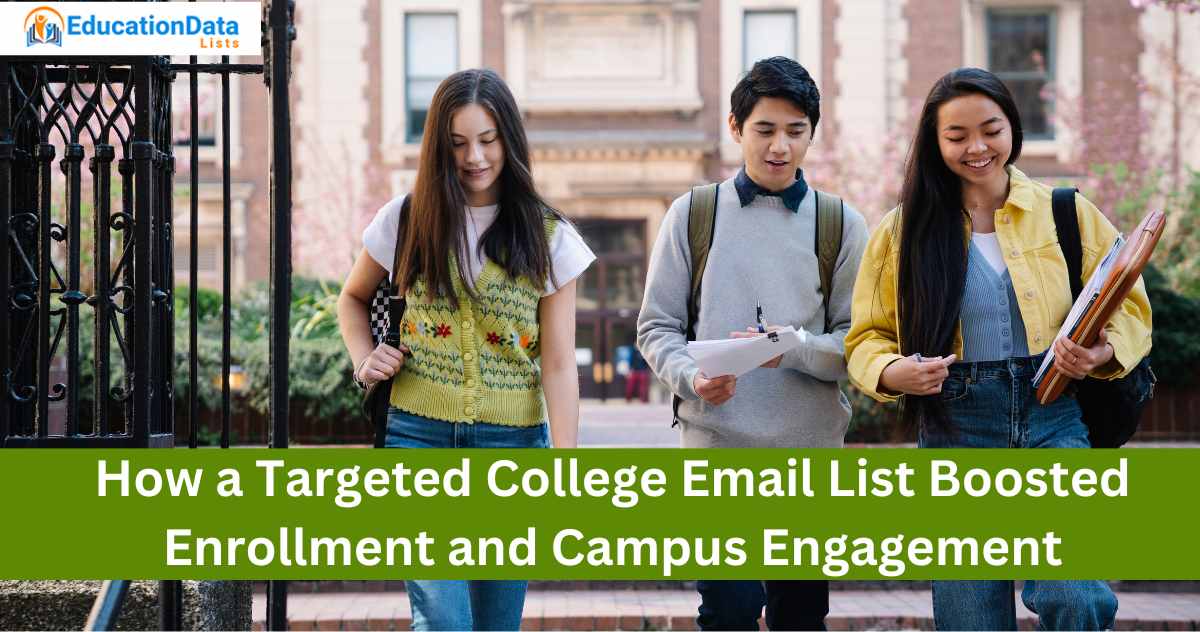
In the digital age, universities must effectively reach both prospective and current students to enhance enrollment and campus engagement. One powerful strategy is utilizing a College Email List. By tapping into a curated list of college emails, universities can communicate directly with students, offering personalized messages that resonate. This targeted approach not only helps in sharing important information but also in creating a sense of community among students. With a well-maintained college email database, universities can send tailored messages that align with the interests and needs of various student groups. This direct line of communication can significantly impact the effectiveness of outreach efforts.
Creating a Focused Email List
Gathering the right data is crucial in building a targeted college email list database. Universities should prioritize capturing information from prospective students through avenues like campus tours, college fairs, and online inquiries. This ensures that the data collected is relevant and actionable.
Developing Impactful Email Campaigns
Crafting engaging email campaigns is essential to capturing students’ interest. Start with compelling content and subject lines that address the recipient’s specific interests. Personalization is key, as it fosters a connection between the university and the student.
Consider the timing and frequency of your emails carefully. Instead of bombarding students with messages, aim to send relevant emails at strategic moments, such as during application periods or before significant campus events.
Using segmentation from your college email database, you can tailor messages to different groups based on their interests and demographics. This ensures that each email feels relevant and valuable to the recipient. Including interactive elements like polls or event RSVPs can also increase engagement and make the emails more dynamic.
Additionally, tracking metrics such as open rates and click-through rates will help you understand what resonates with your audience. Using this data, you can continually refine and optimize your email campaigns for better results. Experimenting with different types of content and subject lines can further enhance the effectiveness of your communication efforts.
Increasing Enrollment with Email Marketing
Leveraging targeted email campaigns can significantly drive enrollment numbers. A well-timed email highlighting application deadlines and campus life can boost application rates. Personalization plays a crucial role; messages that cater to the recipient’s interests and academic goals are more likely to elicit a positive response. Segmentation within your college email database enables universities to deliver tailored content, increasing the likelihood of engagement. Additionally, tracking metrics such as open and click-through rates provides insight into campaign effectiveness, allowing for continuous improvement. By analyzing past successes and trends, universities can optimize their email marketing strategies to better connect with potential applicants.
Improving Campus Engagement
Universities can use email marketing to promote events, workshops, and activities, ensuring students stay informed about opportunities to get involved. By highlighting various campus happenings, universities can encourage students to participate in activities that align with their interests.
Embedding surveys or polls in emails can also be beneficial. These tools allow institutions to gather valuable feedback and understand student preferences, making future events and activities more appealing. Additionally, creating a calendar of upcoming events and sharing it via email can help students plan and prioritize their participation.
Interactive elements like event RSVPs in emails can also streamline the process for students, making it easier for them to commit to attending. Regular updates and reminders about campus events can foster a sense of community and keep students engaged throughout the academic year.
Segmenting the email list based on student demographics or interests ensures that the information is relevant to the recipients, increasing the chances of student participation. This targeted approach helps universities build a vibrant campus life where students feel connected and involved.
Evaluating Success and Enhancing Strategies
Monitoring key metrics such as open rates, click-through rates, and conversion rates is essential for evaluating the effectiveness of your email campaigns. These metrics provide insights into which aspects of your campaigns are working and which need improvement. Gathering feedback from students through surveys or polls embedded in emails can also offer valuable information on their preferences and interests. This data can help universities adjust their messaging, timing, and content to better align with student needs.
Experimenting with different types of content, subject lines, and segmentation criteria can lead to more effective email strategies. For example, universities might find that certain subject lines or email formats result in higher engagement rates. Testing these variables allows institutions to fine-tune their approach and improve the impact of their communications.
Regularly reviewing and analyzing the collected data ensures that your email marketing efforts remain dynamic and responsive. By staying attuned to student feedback and engagement metrics, universities can continuously refine their strategies, leading to more successful outreach and higher levels of student engagement.
Summary and Future Prospects
A focused list of college emails offers universities a strategic advantage in enhancing student outreach and engagement. With a streamlined list, institutions can create impactful campaigns that resonate with students’ interests and needs. Utilizing segmentation and personalization, universities can ensure that their messages are both relevant and effective.
As the landscape of higher education marketing continues to evolve, there are exciting opportunities on the horizon. For instance, incorporating AI-driven personalization can take email campaigns to the next level, offering even more tailored content to recipients. Interactive email features, such as embedded videos or quizzes, can also drive higher engagement rates.
By continuously refining their email strategies based on data analytics and student feedback, universities can stay ahead of trends and maintain a robust communication channel. The ongoing adaptation and innovation in email marketing will be crucial for universities aiming to connect with students in meaningful and impactful ways.





Leave a Reply